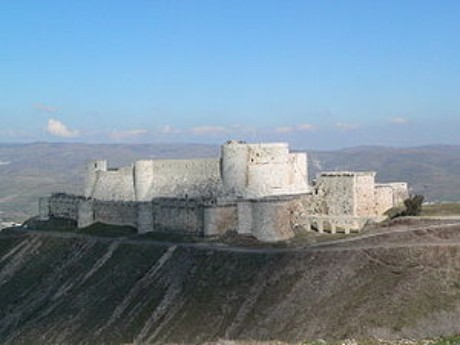
The Crac des Chevaliers (Castle of the Knights) was the most famous castle built in the Holy Land. T. E. Lawrence (immortalized as Lawrence of Arabia) called it "per haps the best preserved and most wholly admirable castle in the world". It was built in 1031 on the northern end of a spur of rock in order to control the Horns Gap, which was the only way to get from Antioch to Beirut and vice-versa year-round. It was originally used by the emir of Aleppo, but was captured by Crusaders led by Raymond IV of Toulouse during the First Crusade in 1099, and subsequently abandoned.
The land around the Crac was occupied by Christian colonists, and the flag be came the flag of the Knights Hospitallar, a white cross on a red field, rather than the flag of any country. The castle was so important that two Masters of the Knights Hospitallar were former castellans (lords of the castle) of the Crac: Hugues de Revel, and Nicolas Lorgne. It was well prepared for sieges, with nine cisterns, a berquilla (large cistern open to the sky) between the other and inner walls, a windmill on one of the towers, ovens, and huge oil jars. Unfortunately, it never lasted more than six weeks at the final siege. Baibars used miners to destroy the walls and sent his siege equipment in. He also faked a message from the master of the Knights Hospitallar telling the garrison to surrender.
The inner curtain wall is 331/3 y. (30 m.) thick and has five guard towers 30 ft. (9 m.) thick. The outer wall is 2 y. (3 m.) thick and has seven guard towers, each 9 - 11 y. (8 - 10 m.) thick. There is a moat between the inner and outer walls, as well as a courtyard between which led to the inner buildings, which in cluded a meeting hall, a chapel,.a storage facility, and two stables, and which were rebuilt by the Knights Hospitallar in a Gothic style. There were additional storage facilities dug into the cliff beneath the fortress, which would have allowed the Knights Hospitallar to withstand a five-year siege.